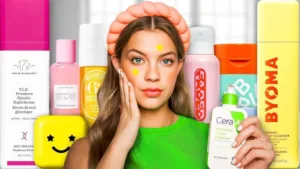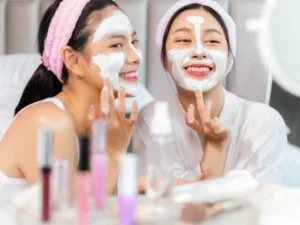News
Tailored Beauty: The Importance of a Personalized Skincare Routine
Part 1: Understanding Why Personalization Matters
Every individual’s skin is unique, shaped by genetics, environment, lifestyle, and age. Understanding this uniqueness is the cornerstone of effective skincare. A personalized routine acknowledges that there is no “one-size-fits-all” solution and prioritizes products and practices tailored to the skin’s specific needs.
The Uniqueness of Skin
Skin varies not only in type—oily, dry, combination, sensitive, or normal—but also in its specific concerns and sensitivities. These differences influence how the skin responds to topical products and environmental factors:
Oily skin: Characterized by excess sebum production, it is prone to clogged pores and acne but may show slower signs of aging.
Dry skin: Often flaky, tight, and sensitive to harsh ingredients, it requires intensive hydration and barrier support.
Combination skin: Exhibits both oily and dry areas, typically an oily T-zone and drier cheeks, necessitating careful balancing of products.
Sensitive skin: Easily irritated by external factors, including harsh chemicals, fragrances, or environmental stressors.
Normal skin: Well-balanced and resilient, though still responsive to nutrition, hydration, and lifestyle factors.
Recognizing your skin’s type and characteristics is the first step toward a routine that truly benefits your complexion.
Why Generic Skincare Routines Often Fall Short
Many commercial routines target broad categories, promising universal results. While convenient, these routines often fail because:
Over-simplification: They do not account for specific concerns like pigmentation, acne scars, or rosacea.
Mismatched ingredients: Products may contain active ingredients that are too strong or too weak for a particular skin type.
Inflexibility: Generic routines rarely adapt to seasonal changes, lifestyle variations, or aging-related needs.
Over-treatment or under-treatment: Without personalization, some areas may be neglected, while others receive excessive care, potentially causing irritation or imbalance.
Generic routines might produce temporary results, but long-term skin health requires thoughtful customization.
The Science Behind Personalized Skincare
Skin is a complex organ with multiple layers, each responding differently to external stimuli:
Epidermis: The outermost layer acts as a barrier, retaining moisture and protecting against pathogens. Ingredients that strengthen the barrier, like ceramides or fatty acids, must be chosen based on skin type.
Dermis: Rich in collagen and elastin, responsible for elasticity and resilience. Ingredients supporting collagen production, like vitamin C or peptides, provide anti-aging benefits tailored to individual skin concerns.
Sebaceous glands: Regulate oil production. Overactive glands in oily skin may require gentle cleansing and oil-control ingredients, while dry skin needs supportive oils and humectants.
Microbiome: Each individual has a unique skin microbiota that influences sensitivity, immunity, and hydration. Personalized routines consider microbiome-friendly products to maintain balance.
By understanding the biology of the skin, one can select ingredients and products that work synergistically with the skin’s natural processes.
Skin Concerns Require Individual Attention
Different skin concerns require targeted solutions:
Acne-prone skin: Needs balancing actives that reduce sebum and prevent clogged pores without over-drying. Salicylic acid, tea tree oil, or gentle clay masks can be incorporated mindfully.
Hyperpigmentation: Requires brightening agents like vitamin C, niacinamide, or botanical extracts, combined with sun protection to prevent further darkening.
Aging skin: Focuses on collagen support, antioxidant protection, and barrier reinforcement. Ingredients like retinoids, peptides, and hydrating oils can be personalized based on tolerance.
Sensitivity and redness: Calls for calming and anti-inflammatory ingredients, such as chamomile, aloe vera, and ceramides.
A one-size-fits-all approach may worsen concerns, highlighting the importance of personalization.
Lifestyle and Environmental Factors Affect Skin Differently
Personalized skincare also considers the environment and lifestyle:
Climate: Humid regions may need lighter products, while dry climates require richer hydration.
Pollution exposure: Urban dwellers benefit from antioxidants and gentle cleansers to combat environmental stress.
Sun exposure: Individuals with higher sun exposure need robust sunscreen protection and repair-focused ingredients.
Stress and sleep: Chronic stress or poor sleep can exacerbate inflammation and aging, requiring tailored calming and restorative products.
These factors interact with inherent skin characteristics, emphasizing why customization is critical.
Personalization Enhances Efficacy
Tailoring skincare routines ensures that:
Ingredients are effective and appropriate for the specific skin type.
Active compounds are used at safe concentrations to maximize benefit without irritation.
Routines adapt to changing conditions like seasons, stress, or hormonal fluctuations.
Overlapping concerns, such as acne and sensitivity, are addressed without compromise.
Personalized skincare transforms the routine from a generic habit into a strategic, effective practice.
The Psychological Impact of Personalization
Beyond physical benefits, personalized skincare fosters mental well-being:
Confidence: Seeing tangible improvements reinforces self-esteem and body positivity.
Mindfulness: Crafting a routine tailored to personal needs encourages intentional self-care.
Empowerment: Understanding one’s skin and selecting suitable products creates a sense of control and agency over health and appearance.
When skincare aligns with both the biology of the skin and the individual’s lifestyle, it becomes a holistic practice, nurturing body and mind.
Conclusion of Part 1
Personalization is the key to effective skincare. Every individual’s skin is unique, influenced by genetics, environment, lifestyle, and age. Generic routines often fail to address specific concerns, respond appropriately to changing conditions, or prevent irritation. Understanding skin biology, recognizing personal concerns, and factoring in lifestyle elements empower individuals to build routines that are effective, sustainable, and rewarding.
With this foundation, we can move to Part 2, which will explore how to build a personalized skincare routine, including identifying skin type, choosing suitable products and ingredients, combining treatments safely, and adjusting routines as life and environment change.

Part 2: Building a Personalized Skincare Routine
Creating a personalized skincare routine is about understanding your skin’s unique needs and aligning products, ingredients, and practices to support its health and appearance. A thoughtful approach maximizes efficacy, minimizes irritation, and adapts to evolving conditions like seasonal changes, stress, or hormonal fluctuations.
Step 1: Identifying Your Skin Type and Concerns
The first step in personalizing a routine is a comprehensive understanding of your skin. Key factors include:
Skin type: Dry, oily, combination, sensitive, or normal. Observing how your skin behaves over a few weeks helps determine its baseline characteristics.
Specific concerns: Acne, hyperpigmentation, fine lines, dullness, redness, or sensitivity. Documenting these concerns guides product selection.
Reaction patterns: Note how skin responds to environmental changes, new products, or lifestyle habits. Reactions indicate strengths, weaknesses, and sensitivities.
Seasonal and hormonal variations: Skin may become drier in winter or oilier during hormonal cycles, requiring adaptable routines.
By accurately assessing these aspects, you can choose targeted interventions rather than generic solutions.
Step 2: Choosing Suitable Products and Ingredients
Selecting products and ingredients tailored to your skin type and concerns is critical. Consider the following:
Cleansers:
Dry skin: Cream-based, hydrating cleansers with aloe vera, honey, or glycerin.
Oily skin: Gentle foaming cleansers with green tea, salicylic acid, or clay.
Sensitive skin: Fragrance-free, calming cleansers with chamomile or calendula.
Exfoliants:
Enzyme-based or mild chemical exfoliants for sensitive skin.
Clay masks or gentle scrubs for oily or combination skin.
Limit frequency to avoid over-exfoliation and barrier damage.
Moisturizers:
Dry skin: Rich creams, oils like argan or rosehip, and humectants like hyaluronic acid.
Oily skin: Lightweight gels or water-based moisturizers.
Combination skin: Layered approach—oil-free in T-zone, richer creams on dry areas.
Active ingredients:
Vitamin C or niacinamide for brightening.
Retinoids or peptides for anti-aging.
Tea tree oil or benzoyl peroxide for acne-prone skin.
Sun protection:
Daily application of broad-spectrum SPF 30+ is essential for all skin types.
Mineral sunscreens (zinc oxide or titanium dioxide) for sensitive or reactive skin.
Choosing the right products involves not only selecting active ingredients but also considering formulation, texture, and delivery methods suitable for your skin.
Step 3: Combining Treatments Safely
A personalized routine often involves multiple products and active ingredients. Combining them safely ensures effectiveness without irritation:
Layering: Apply light, water-based products first, followed by heavier creams or oils.
Active compatibility: Some actives, like retinoids and vitamin C, may cause irritation if used together; spacing applications or using at different times of day can prevent adverse reactions.
Patch testing: Introduce new ingredients individually to assess tolerance.
Avoid overloading: Less is often more; excessive products can disrupt the skin barrier and cause reactions.
Thoughtful combination maximizes benefits while maintaining skin health.
Step 4: Adjusting Routines for Seasonal and Life Changes
Skin needs fluctuate throughout the year and with life events. Adaptations include:
Seasonal adjustments:
Winter: Richer moisturizers, hydrating serums, and protective oils.
Summer: Lightweight gels, oil-control ingredients, and consistent SPF application.
Lifestyle and environment:
Travel may require portable, multifunctional products.
High pollution or sun exposure periods necessitate antioxidants and enhanced protection.
Hormonal changes:
Pregnancy, menstruation, or menopause can alter oil production, sensitivity, and hydration, requiring tailored adjustments.
Monitoring skin and adjusting routines proactively ensures continued effectiveness.
Step 5: Establishing a Practical Daily Routine
A consistent, structured routine supports long-term results:
Morning routine: Cleanse, apply antioxidant serum, moisturize, and finish with SPF.
Daytime habits: Reapply sunscreen, hydrate, and minimize environmental stressors.
Evening routine: Cleanse, apply targeted treatments or serums, moisturize, and nourish the skin overnight.
Weekly rituals: Gentle exfoliation, masks, or restorative treatments enhance results and maintain balance.
Consistency, rather than intensity, is the key to a sustainable, effective routine.
Step 6: Tracking Progress and Refining
Personalization is an ongoing process. Monitoring progress ensures the routine remains effective:
Document changes: Track improvements in texture, tone, hydration, and overall appearance.
Adjust products as needed: Introduce new actives gradually, replace ineffective products, or scale back if irritation occurs.
Listen to your skin: React to feedback—redness, dryness, or breakouts indicate the need for adjustment.
Refining routines over time aligns skincare practices with evolving needs, maximizing results.
Step 7: Mindful Application and Self-Care
Skincare is also a ritual of self-care. Mindful application promotes both physical and mental well-being:
Apply products with gentle, deliberate motions to enhance absorption and circulation.
Take moments of reflection or relaxation during routines to reduce stress.
Engage with your skincare as a daily affirmation of self-care, enhancing confidence and mindfulness.
The psychological benefits of mindful skincare amplify the physical improvements achieved through personalization.
Step 8: Avoiding Common Pitfalls
Even personalized routines can fail if certain mistakes occur:
Overcomplication: Excessive products or steps can overwhelm the skin and the user.
Ignoring patch testing: Introducing multiple new ingredients simultaneously risks irritation.
Neglecting environmental factors: Skincare without sun protection or pollution defense is less effective.
Inconsistency: Irregular application prevents the skin from benefiting fully.
Avoiding these pitfalls ensures that personalization leads to long-term, sustainable results.
Step 9: Integration with Lifestyle Factors
Effective personalization considers lifestyle alongside topical care:
Nutrition, hydration, sleep, stress management, and exercise all influence skin response.
Skincare routines are complemented by lifestyle practices, creating a holistic approach that enhances radiance, resilience, and overall skin health.
The synergy between internal health and external care magnifies the benefits of a personalized routine.
Step 10: Conclusion of Part 2
Building a personalized skincare routine requires understanding skin type, concerns, and sensitivities, selecting appropriate products and ingredients, combining treatments safely, and adjusting routines to reflect seasonal, hormonal, and lifestyle changes. Mindful application, consistent practice, and ongoing refinement enhance results, reduce irritation, and promote long-term skin health.
With this foundation, we are prepared for Part 3, which will explore the long-term benefits of personalization, mindful practices, and the psychological rewards that come from a routine tailored to your unique skin.

Part 3: Long-Term Benefits and Mindful Practices
A personalized skincare routine is more than a daily habit—it is an investment in long-term skin health, resilience, and well-being. When tailored to individual needs, a routine maximizes the efficacy of products, reduces irritation, and supports the skin’s natural functions. Moreover, the act of caring for your skin cultivates mindfulness, confidence, and a deeper connection between inner and outer wellness.
Enhanced Skin Health and Radiance
Personalization ensures that the skin receives exactly what it needs:
Targeted treatment: Active ingredients address specific concerns, such as acne, hyperpigmentation, or fine lines, without overburdening the skin.
Balanced hydration and oil control: Correctly formulated moisturizers, serums, and treatments maintain optimal moisture levels and prevent overproduction of sebum.
Improved barrier function: Tailored routines support the skin’s natural defenses, reducing sensitivity, redness, and environmental damage.
Long-term resilience: Consistent, personalized care strengthens the skin’s natural repair mechanisms, making it more resistant to aging and external stressors.
Over time, these benefits result in visibly healthier, more radiant skin that responds better to treatments and external factors.
Minimizing Irritation and Adverse Reactions
Generic routines or mismatched products can cause irritation, inflammation, or allergic reactions. Personalization reduces these risks by:
Using compatible ingredients: Prevents conflicts between actives, such as combining retinoids with harsh acids improperly.
Adjusting concentration and frequency: Ensures the skin can tolerate treatments without overloading.
Recognizing individual sensitivities: Avoids fragrances, alcohol, or other triggers that may provoke reactions.
This thoughtful approach protects the skin, maintaining comfort and preventing setbacks that could compromise progress.
Adapting to Changes Over Time
Skin is dynamic and evolves due to age, hormones, lifestyle, and environmental conditions. Personalized routines can adapt accordingly:
Aging skin: Incorporates collagen-boosting and antioxidant-rich ingredients to combat fine lines, sagging, and loss of elasticity.
Seasonal changes: Adjusting product textures and formulations ensures optimal hydration and protection year-round.
Hormonal fluctuations: Acne, dryness, or oiliness can shift during cycles or life stages, requiring flexible routines.
By continually refining the routine, individuals maintain optimal results despite these changes.
Sustainable and Efficient Skincare
Personalized routines promote sustainability by:
Reducing waste: Using only what the skin needs avoids unnecessary product accumulation.
Maximizing efficacy: Each product has a clear purpose, reducing trial-and-error purchases.
Encouraging mindfulness: Thoughtful selection and application reduce impulsive buying and support conscious consumerism.
Sustainability becomes a natural byproduct of customization, benefiting both skin and environment.
Psychological and Emotional Benefits
A personalized skincare routine extends beyond physical appearance, enhancing mental and emotional well-being:
Confidence boost: Clearer, healthier skin improves self-esteem and social comfort.
Mindfulness and self-care: Taking time to understand your skin and apply products mindfully encourages presence and reflection.
Empowerment: Knowledge of one’s skin type, concerns, and responses fosters a sense of control over personal health and appearance.
Stress reduction: Ritualized routines can be calming, offering a daily moment of intentional self-care.
The psychological rewards reinforce the physical benefits, creating a holistic approach to beauty and wellness.
Incorporating Mindful Practices
Mindful application enhances both results and experience:
Gentle massage: Applying products with light, upward strokes improves absorption, circulation, and lymphatic drainage.
Focused attention: Concentrating on sensations during application strengthens the mind-body connection.
Routine reflection: Noting how skin responds to products and environmental factors encourages adaptive care and continuous learning.
Mindfulness transforms skincare from a chore into a rewarding, meditative practice.
Long-Term Habit Formation
Consistency is crucial for lasting benefits. Personalized routines encourage adherence because:
They are tailored to actual needs, making them practical and manageable.
Users experience measurable results, reinforcing continued use.
Flexibility allows integration into lifestyle, reducing burnout or abandonment.
Over months and years, these habits compound, producing sustained improvements in skin health, resilience, and appearance.
Integration with Lifestyle
A truly holistic routine links skincare with overall lifestyle:
Nutrition: Supports skin from within, complementing topical care.
Hydration: Maintains cellular function and barrier integrity.
Sleep and stress management: Enhance repair, regeneration, and hormonal balance.
Exercise and environmental protection: Promote circulation, detoxification, and defense against external stressors.
Personalized routines amplify the benefits of healthy lifestyle choices, creating a synergistic effect on skin health and overall wellness.
Monitoring and Adjusting for Continuous Improvement
Even the most well-designed routine benefits from regular evaluation:
Track progress: Observe changes in texture, tone, hydration, and sensitivity.
Adapt as needed: Introduce new products or actives gradually, modify frequencies, or adjust for environmental or hormonal changes.
Seek professional guidance: Dermatologists or skincare experts can help refine routines for persistent or complex concerns.
Continuous monitoring ensures the routine evolves with the skin, maintaining effectiveness and preventing stagnation.

Conclusion of Part 3
The long-term benefits of a personalized skincare routine extend beyond the surface. By addressing individual skin type, concerns, and sensitivities, these routines enhance appearance, strengthen resilience, reduce irritation, and adapt to changing conditions. They foster mindful self-care, improve confidence, and integrate seamlessly with a healthy lifestyle.
Ultimately, personalized skincare is an investment in both skin and well-being. It reflects a commitment to understanding and nurturing one’s unique needs, cultivating not just radiance and youthfulness, but also mental clarity, mindfulness, and holistic wellness. By embracing this approach, skincare becomes a transformative practice, supporting beauty from the inside out and creating lasting results that grow with time, lifestyle, and experience.
